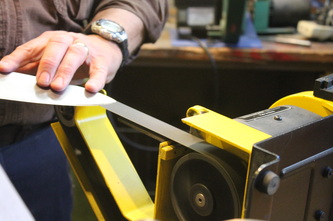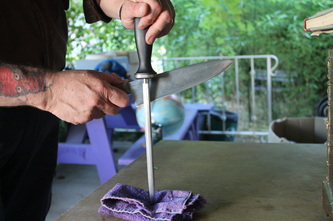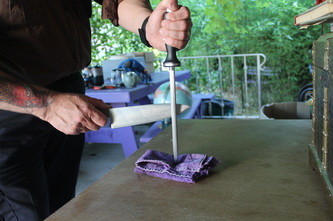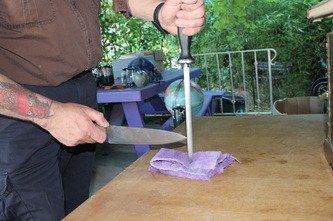FREQUENTLY ASKED QUESTIONS

#1. Question: Are my knives worth sharpening?
Answer: If you use them, then yes, they are worth sharpening. If you're careful with it, a sharp knife is safer than a dull knife, not only that, but a pleasure to use. Your knife does not have to be expensive to feel good in your hand or to deserve a refined edge.
#2. Question: How often should I sharpen my knives?
Answer: When they need it. That will vary from person to person depending on the quality of the knife and the habits of the owner. Proper steeling (see my instructions) will not sharpen a knife, but it will prolong the edge. Proper steeling simply realigns a dented or bent edge. Sharpening removes metal and changes the geometry of the situation. This might be needed every 6 months or once a year... Don't cut on tile and don't put in a dishwasher!
#3. Question: What knives do I need?
Answer: You need what will make you happy... But in all honesty, all you really need is a decent Chef's knife and a good Paring knife. Everything else is just fluff. Okay, maybe you need a serrated knife for cutting crusty bread, but a truly sharp will do the trick with less crumb. That said, I probably have thirty knives in my kitchen. I like to choose a knife depending on my mood and the memories connected to it.
#4. Question: Do I do trades?
Answer: Well, yes I do. What do you have?
#5. Question: What kind of equipment do I use?
Answer: Trade secret... No, really, I use a series of one inch belt sanders of increasingly fine grit, first on a vertical plane and then on a horizontal plane. Then I move to a leather belt loaded with green compound and finally to a leather or paper wheel loaded with white buffing compound. For Scissors and Clippers, I use a large wet grinding wheel at a slow speed. Lighting is very important.
#6. Question: Why is the Steel Magnetized?
Answer: Good question! Smart of you to notice. The steel is magnetized to that if it breaks off tiny slivers and chips from your knife, those bits and pieces stay on the steel instead of ending up in your food.
Answer: If you use them, then yes, they are worth sharpening. If you're careful with it, a sharp knife is safer than a dull knife, not only that, but a pleasure to use. Your knife does not have to be expensive to feel good in your hand or to deserve a refined edge.
#2. Question: How often should I sharpen my knives?
Answer: When they need it. That will vary from person to person depending on the quality of the knife and the habits of the owner. Proper steeling (see my instructions) will not sharpen a knife, but it will prolong the edge. Proper steeling simply realigns a dented or bent edge. Sharpening removes metal and changes the geometry of the situation. This might be needed every 6 months or once a year... Don't cut on tile and don't put in a dishwasher!
#3. Question: What knives do I need?
Answer: You need what will make you happy... But in all honesty, all you really need is a decent Chef's knife and a good Paring knife. Everything else is just fluff. Okay, maybe you need a serrated knife for cutting crusty bread, but a truly sharp will do the trick with less crumb. That said, I probably have thirty knives in my kitchen. I like to choose a knife depending on my mood and the memories connected to it.
#4. Question: Do I do trades?
Answer: Well, yes I do. What do you have?
#5. Question: What kind of equipment do I use?
Answer: Trade secret... No, really, I use a series of one inch belt sanders of increasingly fine grit, first on a vertical plane and then on a horizontal plane. Then I move to a leather belt loaded with green compound and finally to a leather or paper wheel loaded with white buffing compound. For Scissors and Clippers, I use a large wet grinding wheel at a slow speed. Lighting is very important.
#6. Question: Why is the Steel Magnetized?
Answer: Good question! Smart of you to notice. The steel is magnetized to that if it breaks off tiny slivers and chips from your knife, those bits and pieces stay on the steel instead of ending up in your food.
How to use a Steel
The use of a steel is a delicate and generally misunderstood art usually typified by a dramatic florish of the knife and steel, resulting in damaged blades and disappointing edges. It should a gentle and subtle dance which carefully realigns the slightly bent and dented blade. It does not remove metal, it simply prolongs the edge you already have.
Step 1: Position the Steel.
Place the steel vertically on a folded tea towel and hold it firmly point down.
Step 2: Position the Knife.
Hold the knife with the spine touching the guard of the steel, the wide part of the handle for thick knives and the narrow part for thin knives. If your steel does not have a rectangular guard, approximate the angle of the original sharpening, usually around 20 degrees.
Step 3: Steel the Edge.
Starting at the heel of the knife, draw the blade down with a gentle slicing motion all the way to the tip, as if you were slicing a long thin strip off the steel. Do this twice on each side letting the weight of the knife do most of the work.
Step 1: Position the Steel.
Place the steel vertically on a folded tea towel and hold it firmly point down.
Step 2: Position the Knife.
Hold the knife with the spine touching the guard of the steel, the wide part of the handle for thick knives and the narrow part for thin knives. If your steel does not have a rectangular guard, approximate the angle of the original sharpening, usually around 20 degrees.
Step 3: Steel the Edge.
Starting at the heel of the knife, draw the blade down with a gentle slicing motion all the way to the tip, as if you were slicing a long thin strip off the steel. Do this twice on each side letting the weight of the knife do most of the work.
Patron Saint of Knives
2906 NE 43rd St
Vancouver Washington 98663
503-891-9665
2906 NE 43rd St
Vancouver Washington 98663
503-891-9665








